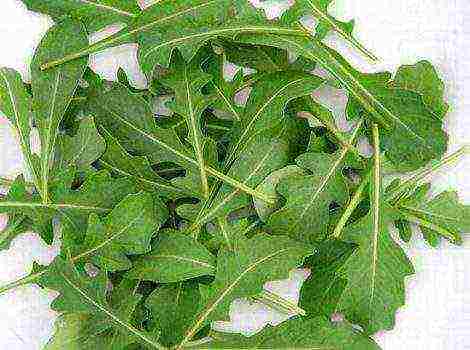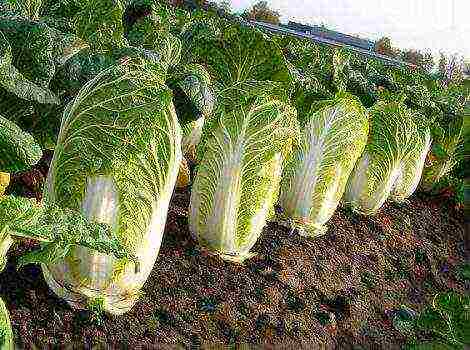Content
- 1 Choosing a dahlia variety that is suitable for growing in pots
- 2 Pot selection
- 3 Landing
- 4 Care
- 5 Pests and methods of dealing with them
- 6 Wintering dahlia
- 7 Advice
- 8 What do you need
- 9 Features of growing dahlias from tubers
- 10 How to grow dahlias correctly
- 11 What care for dahlias is needed
- 12 How to store dahlias in winter
- 13 Choosing a dahlia variety that is suitable for growing in pots
- 14 Pot selection
- 15 Landing
- 16 Care
- 17 Pests and methods of dealing with them
- 18 Wintering dahlia
- 19 Advice
- 20 What do you need
- 21 Dahlia growing
Dahlias popular among gardeners, despite their height, can be grown at home in pots. But at the same time, you need to take into account the specifics of growing and select the appropriate varieties.
Choosing a dahlia variety that is suitable for growing in pots
For planting dahlias at home or on the balcony, varieties with a small root system are selected. Special varieties of indoor low-growing dahlias have been developed - for growing in pots at home. These are pot-dahlias, miniature dahlias, etc. But you can also grow high varieties. It is important to choose the right container for planting and take care of the support if the flower has grown to 85-90 cm.
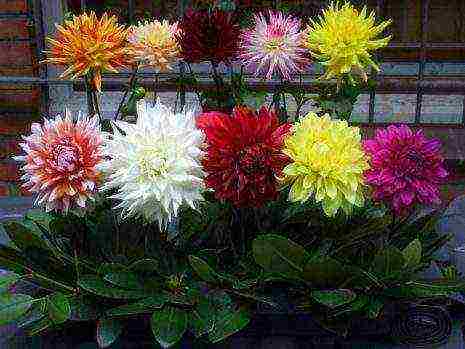
Pot selection
Indoor dahlias can be planted in plastic containers, wooden, wicker, clay, different sizes. What's better?
What container to use
In plastic containers, overheating of the soil is possible, the access of oxygen to the roots is reduced. Wicker baskets do not have these drawbacks, but they are usually short-lived. Wooden boxes are comfortable for flowers, but not decorative enough for a room or balcony. For attractiveness, they can be painted, but then air permeability is impaired. In a clay or ceramic pot, the roots of dahlias do not lack oxygen. These pots are attractive and durable.
I need to find a big pot
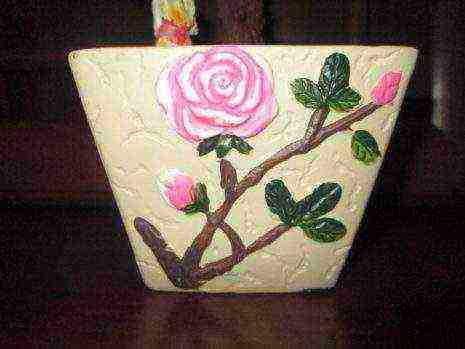
To plant a dahlia, you need a large pot. When choosing a volume, you should take into account the dimensions of the flowers. The size of the root system for low varieties requires a capacity of 4-5 liters. Medium-sized dahlias will feel comfortable in pots of 7-8 liters. For flowers with a height of more than 90 cm, 10 liters or more will be required.
Better to choose a heavy pot
The pot must be heavy. An adult dahlia requires a stable support, so plastic or wicker containers are not suitable. A thick-walled clay pot is able to maintain the stability of the flower.
Drilling holes
Dahlias do not tolerate excess moisture.If the water stagnates in the pot after watering, the roots will die due to the lack of oxygen. It is necessary to ensure the outflow of water through the drainage holes. If there is only one drain hole, several more need to be drilled to improve drainage.

Why is it necessary to rinse the pot thoroughly?
When using already used pots, they must be pre-treated. Clay can contain microorganisms, insect eggs, fungi, accumulate salts, etc. Therefore, before use, the pot should be thoroughly washed with soap and water and disinfected with a chlorine-free product.
Coarse soil mix
Dahlias are demanding on the quality of the soil. You can buy ready-made soil mix or mix it yourself. The soil should be coarse, loosened to provide air access to the roots. Peat, humus, sand are added to it. Experienced growers advise mixing perlite, hygroscopic granules of which remove excess moisture from the soil.

Landing
It is important to correctly determine the timing of planting so as not to spoil the planting material.
Landing dates
If the pots are in an apartment or on a heated balcony, then tubers can be planted as early as late March - early April. If the pots are planned to be exposed to the open air (on the porch, in the garden or on the open balcony), then it is better to wait until May, when even at night it will be at least 120C.
Potted dahlias begin to bloom about 45-50 days after planting. This period can be reduced by providing the plants with warmth and sunlight.
Filling the pot
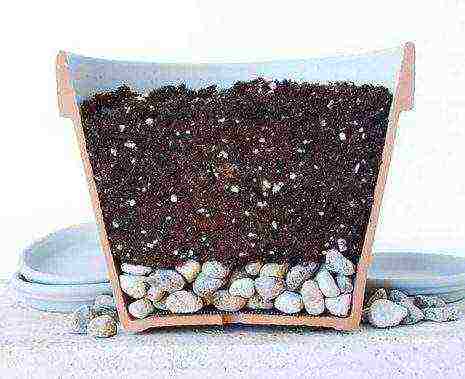
When filling the pot, pay special attention to the drainage layer.
ADVICE!
Experienced growers advise placing one or two coffee filters on the bottom of the pot. They absorb moisture well and block the drainage holes, blocking them from pests.
You can add gravel to the bottom of the pot. The height of the drainage layer is about 15 cm. The drainage holes must remain free to allow water to drain out. Soil is poured onto the drainage. The height of the soil depends on the pot - about 20 cm should be left to the top edge.
The tubers are planted to a depth of about 15 cm. After planting, germination and backfilling of the tubers, the distance from the ground to the edge of the pot should be at least 2 cm. The backfilled soil is moistened and slightly crushed - the ground should be loose.
Planting tubers
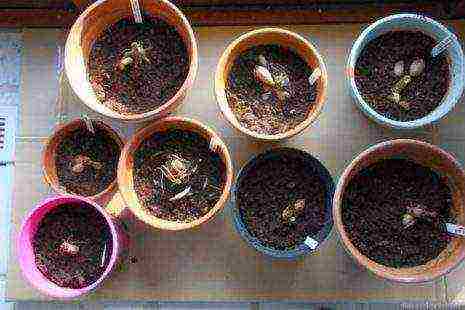
Tubers with short roots should be planted. If the roots are allowed to elongate, they will intertwine and be damaged when untangled. Root restoration will delay the growth and flowering of the dahlia.
The tuber is laid on the ground with the eye upwards so that the stem can grow unhindered. It is desirable that the sprout is located approximately in the center of the pot, and the distance from the ends of the roots to the wall of the pot is at least 5-6 mm.
The tuber is sprinkled with moistened soil, you do not need to fill up the peephole. As the stem emerges and grows, the soil is added, but very carefully so as not to damage the delicate sprout. The addition of soil continues until the distance to the edge of the pot decreases to 2-3 cm.
The pot with the planted dahlia is placed in a warm, bright place protected from the wind. Slight shading is possible in the evening.
Watering the soil
 You may be interested in:
You may be interested in:
For planting, the soil is moistened. After planting, the dahlia does not require watering, the soil is only lightly sprinkled with warm water. Watering begins a few days later, after the formation of absorbent roots.
Fertilizers
For rapid growth and lush flowering, flowers require feeding. Dahlias respond well to fertilizers based on algae and fish, bone meal. You can buy a ready-to-use plant feed mixture at a specialty store.
Apply fertilizers with high nitrogen levels carefully. An excess of nitrogen leads to diseases of dahlias, they bloom poorly, the tubers do not tolerate wintering well.
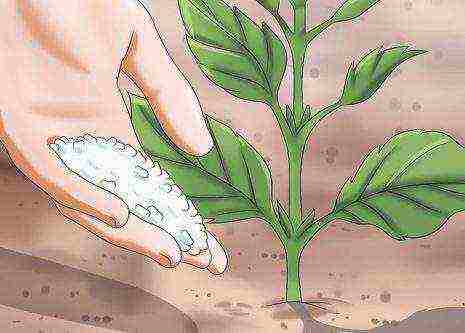
Inserting a stanchion and anchoring the stem
For flowers of medium to tall growth, additional support will be required so that the stem can support the weight of the flower. As a rule, the height of the support does not exceed 120 cm. The support must be stable - it is inserted into the ground to the very bottom and, if necessary, is additionally attached to the pot (for example, using a wire).
The stem is carefully tied to the support.
ADVICE!
Dahlias do not tolerate transplanting well, so experienced flower growers advise to immediately plant the tuber in a pot in which the flower will grow.
Care
Caring for potted dahlias is simple and includes:
- watering,
- loosening of the soil,
- top dressing,
- protection from diseases and pests.
If potted dahlias grow in the open air (on an open balcony, veranda, porch), then in adverse weather conditions they are simply temporarily brought into the room.
Watering the stem and soil
Dahlias do not tolerate excess moisture. Watering frequency depends on the weather. This is usually two to three times a week. If it's cool, just once is enough, depending on the condition of the soil. In dry and hot weather, you can water daily without allowing moisture to stagnate.
ADVICE!
After watering, it is necessary to loosen the soil. Otherwise, a dried earth crust is formed, which does not allow oxygen to pass to the roots.
Lighting
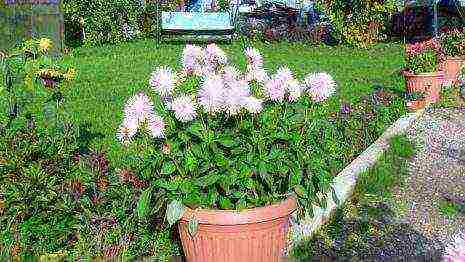
Dahlias love sunlight. For high-quality growth and flowering, they need about 6-8 hours to be in direct sunlight. If the pots are on the balcony, choose the sunniest place for them. If dahlias are growing in a room, then it is useful to make up for the lack of sunlight with fluorescent lamps. The lamp can be installed immediately after planting at a level of 15 cm above the ground. As the dahlia grows, the lamp rises.
Fertilizer timing
Dahlias need a lot of potassium and phosphorus, to a lesser extent - nitrogen. Top dressing begins in June. Fertilizers are applied every two weeks when watering. Overfeeding with fertilizers should be avoided. Top dressing continues until September.
Removing the lower leaves
Around mid-July, the lower leaves are removed from the stem to improve air circulation. It also protects plants from powdery mildew disease.

Spraying with insecticide and fungicide
To protect against pests, potted dahlias are treated with a fungicide or insecticide twice a month.
Pests and methods of dealing with them
Yellowed and curled leaves are a signal of the appearance of aphids. If the colonies are single, then the damaged leaves are simply removed. In case of severe infection, an insecticide treatment is necessary.
Slugs gnaw through or completely destroy the leaves. To combat them, metaldehyde preparations, superphosphate, red pepper are effective - they scatter on the ground.
Plant bugs cause leaf boring. To get rid of them, dahlias are sprayed with insecticide. The treatment is best done in the morning, when the bugs are inactive.
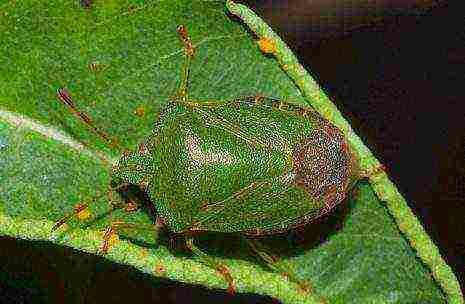
Earwigs spoil the buds, gnawing out their core. Watering once a week with a decoction of wormwood or celandine helps from earwigs.
When mold appears, fungicide treatment helps.
In case of a disease with powdery mildew, treatment with a preparation containing copper is necessary. Sulfur treatment can be applied.
Wintering dahlia
With the first autumn frosts, even if dahlias grow in the house, you need to think about winter rest. Before winter, the dahlia is cut, leaving 4-5 cm of the stem. The tubers can be dug up or left in the same pots in which they grew.
The dug tubers are carefully cleaned from the ground, treated with a solution of potassium permanganate of medium brightness and dried. They are stored in a cool dry place at an air temperature of about 50C. So that they do not dry out during storage, the tubers can be sprinkled with sawdust, sand, peat.
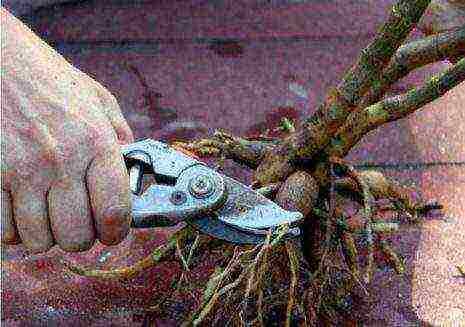
During wintering, protruding roots are cut off in a pot, the pot is wrapped in newspaper in several layers and packed in an opaque bag. Until spring, the pots should be kept in a cool dry place.
3 parts: Providing suitable conditions Planting dahlias Plant care
Dahlias have beautiful and vibrant flowers in a wide variety of colors. These are rather tall plants, which is why many gardeners are skeptical about the possibility of growing them in pots. However, dahlias thrive in fairly large pots, but taller varieties may require additional props. Provide the plants with the right conditions and a little attention, and you will enjoy spectacular flowers all summer long.
Part 1 Ensuring the right conditions
-
 Choose a dahlia variety that fits your needs.
Choose a dahlia variety that fits your needs.
Dahlia tubers can be purchased at a garden supply store or ordered online. Dwarf and low varieties are best suited for growing in pots. Some species can grow up to 1.5 meters, so for a higher variety you will need a larger pot.
- The short and medium-sized varieties include, for example, Piccolo, which grows to a height of 45 centimeters, and Figaro, which grows to only 30 centimeters. Taller dahlias include varieties such as Manhattan (grows up to 90 centimeters) and Duet (can grow up to 2.5 meters).
- One tuber requires a space of 30-60 centimeters, so in most cases the plants are grown in pots one at a time.
-
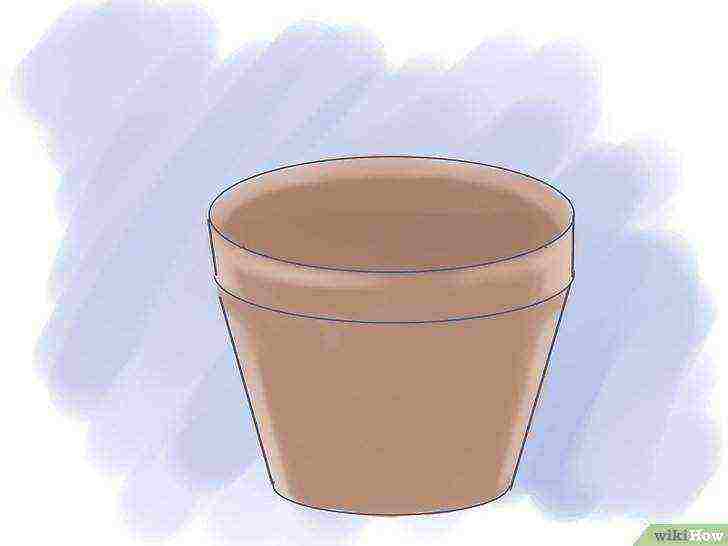 Choose a pot that is at least 30 x 30 centimeters in size.
Choose a pot that is at least 30 x 30 centimeters in size.
A fairly heavy pot with a depth of at least 30 centimeters and a diameter of at least 30 centimeters will do. Usually pots of this size hold 20-25 liters of soil.
- If you are going to grow tall dahlias, choose a 60 x 60 cm pot that holds about 100 liters of soil.
-
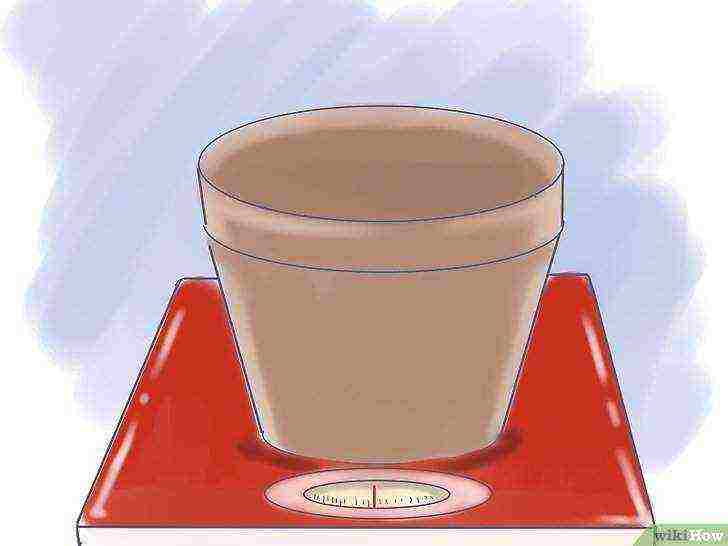 Choose a heavy pot if you want to grow tall dahlias.
Choose a heavy pot if you want to grow tall dahlias.
Dahlias 1–1.5 meters tall often have heavy buds, and a light pot may not support their weight and tip over. In addition, tall dahlias require a support, which adds even more weight.
- Plastic pots are too light, so use heavier ceramic or terracotta pots.
- Keep in mind that terracotta and unglazed ceramic pots absorb water, and if left outside during the winter, it can freeze and cause the pot to crack.
-
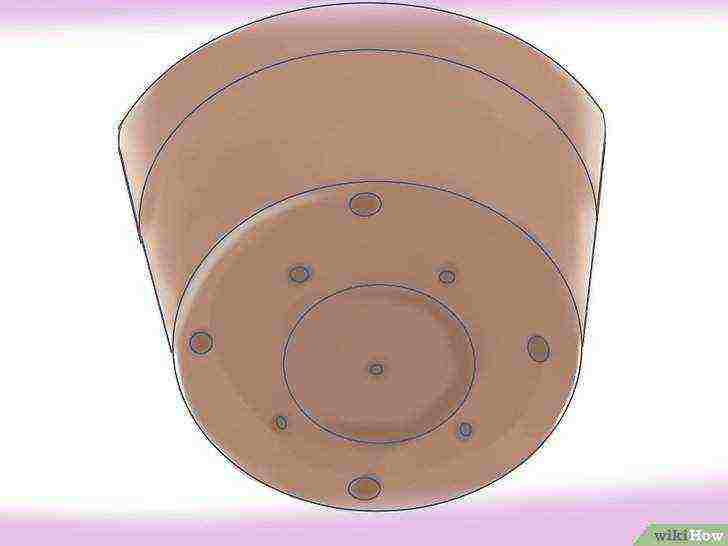 Drill drain holes if necessary.
Drill drain holes if necessary.
This step is not necessary if the pot already has multiple drainage holes to allow excess water to drain. However, if the pot has shallow holes or only one hole in the middle, drill some extra holes to improve drainage.
- Dahlias prefer good drainage. Although they require a lot of water, their thin roots start to rot if the soil is saturated with moisture.
- To improve drainage, cover the bottom of the pot with about 5 centimeters of gravel.
-
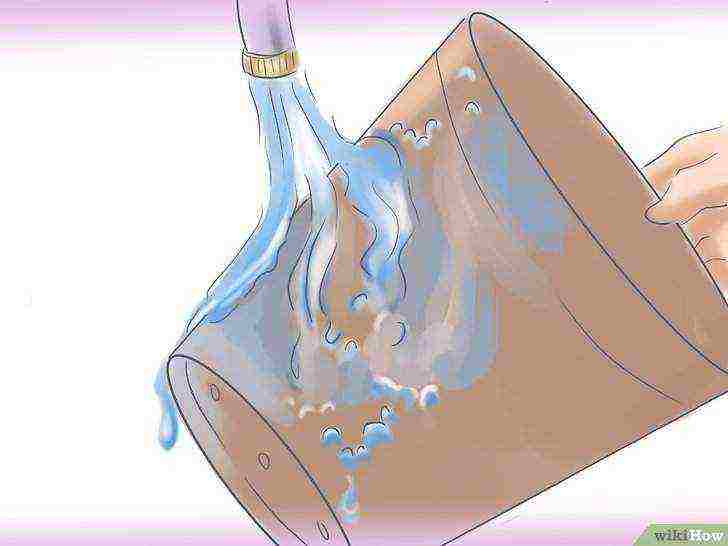 Wash the pot with warm water and mild soap.
Wash the pot with warm water and mild soap.
Disease can be transmitted through a dirty pot, and insect eggs can remain in the ground at the bottom of the pot. Get rid of this danger: wash the pot before planting the plant in it. Use mild soap and water for this.
- Rinse the pot thoroughly to remove any soap residue.
- It is especially important to wash the pot if there have been other plants in it before.
-
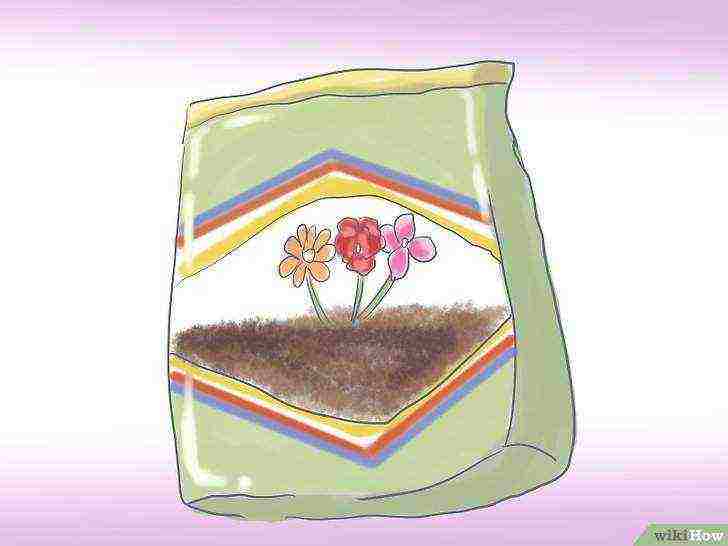 Choose a fertile potting mix with good drainage.
Choose a fertile potting mix with good drainage.
Standard potting soil is too porous and can cause water to accumulate. To get a suitable soil, mix 2 parts potting soil and 1 part peat moss or rotted manure.
- Please note that regular garden soil is not suitable for potted plants. Be sure to purchase soil specifically made for indoor plants.
Part 2 Planting dahlias
-
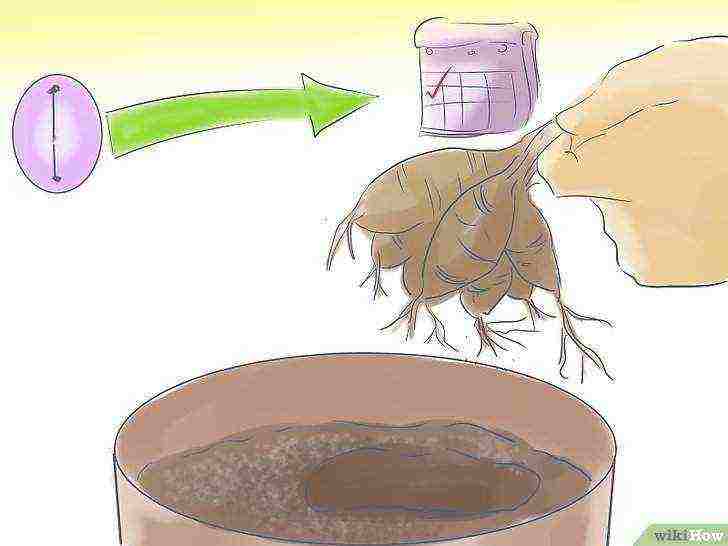 Plant the tubers in mid-spring.
Plant the tubers in mid-spring.
In the Northern Hemisphere, dahlias should be planted in the spring, from April to early June.These plants are sensitive to cold, so only put the pot outside after the last frost is over.
- If spring frosts are common in your area and you don't want to wait until they end, plant the dahlias indoors and then take the pots outside.
-
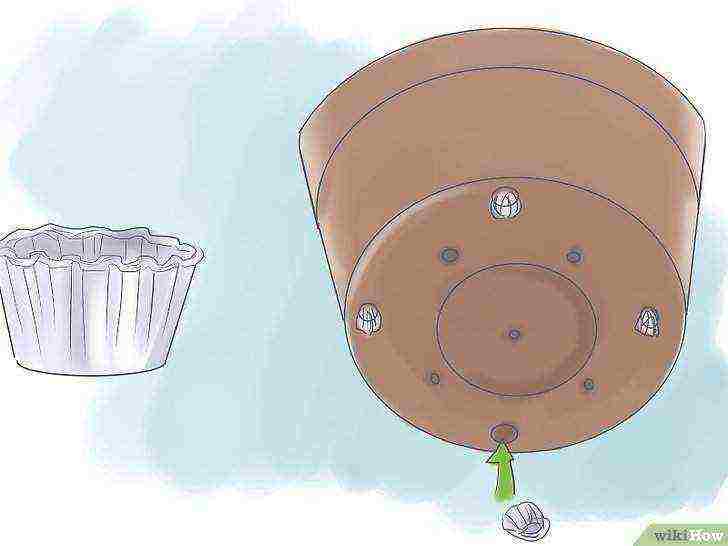 Cover the bottom of the pot with a thin layer of gravel.
Cover the bottom of the pot with a thin layer of gravel.
Place gravel on the bottom of the pot so that it forms a layer no thicker than 1.3 centimeters.
-
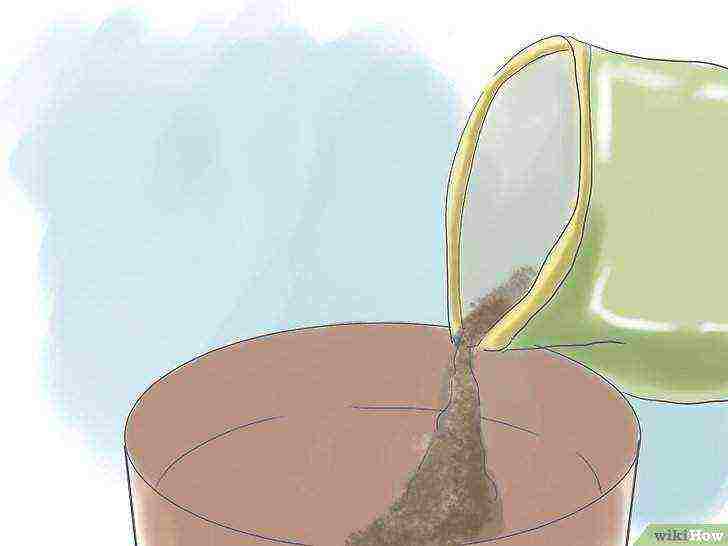 Put soil in the pot.
Put soil in the pot.
The soil level should be 13-18 centimeters below the edges of the pot. No need to tamp the ground. Just put it in a pot and leave it as it is. Remember that dahlias prefer loose, water-permeable soil.
- Finally, plant the dahlia tuber 10 to 15 centimeters deep, leaving 2 to 3 centimeters between the soil and the edge of the pot.
- To maintain the specified distances, first fill in enough soil so that the soil level is 13-18 centimeters below the edges of the pot.
-
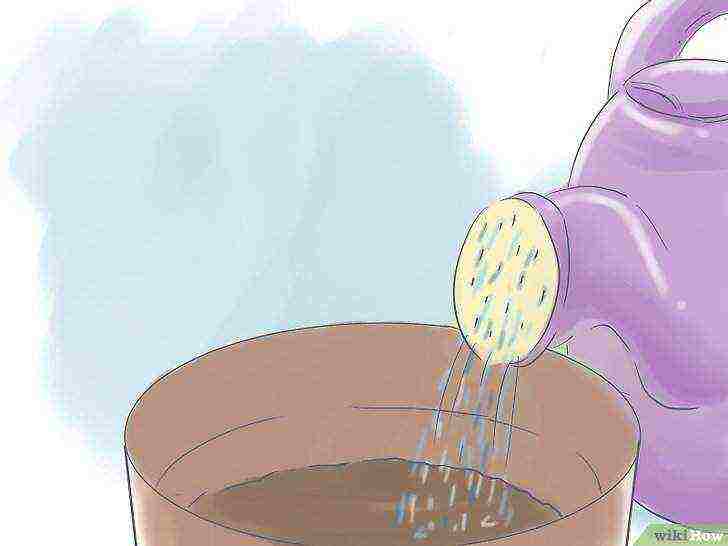 Water the soil lightly to keep it from getting too wet.
Water the soil lightly to keep it from getting too wet.
The soil should be slightly wet, but not soaked in water enough to stick together. Try using a watering can rather than a garden hose.
-
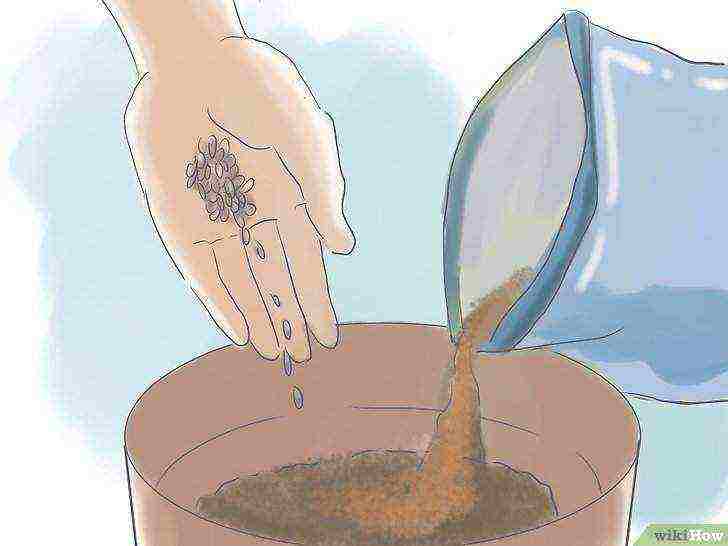 Stir in fertilizer to the topsoil.
Stir in fertilizer to the topsoil.
For the development of the root system and normal growth, dahlias require a large amount of fertilizer. Use a slow-release general purpose fertilizer such as bone meal or seaweed fertilizer.
- Any fertilizer suitable for flowers or vegetables is suitable for dahlias.
- Fertilizers are commercially available with specific indices N: P: K, which mean the content of nitrogen (N), phosphorus (P) and potassium (K). For dahlias, fertilizers are suitable 5:10:15, 5:10:10, or 10:20:20.
- Use fertilizers with a higher nitrogen content early in the season and then gradually lower the nitrogen concentration.
- Read and follow the instructions supplied with the fertilizer.
- Stick a peg in the ground to support taller varieties of dahlias.
If you have chosen a variety that grows taller than 90 centimeters, the plant will need support in the form of a rigid metal or wooden rod. Place a support in the ground before planting the tuber. If you stick it in after planting the tuber, you risk damaging the root system.
- Stick the peg into the ground near where you will plant the tuber. Choose a peg that touches the bottom of the pot and protrudes at least 90 centimeters above the ground.
- For a 30-centimeter pot, a 1.2-meter pole will work.
- When the plant has a stem, loosely tie it to a post.
-
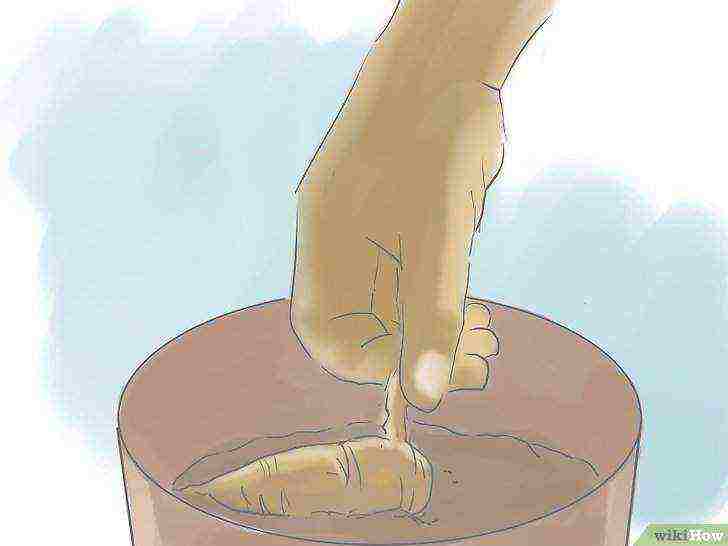 Plant the tuber sideways.
Plant the tuber sideways.
Lay the tuber horizontally so that the eye is in the middle of the pot. The peephole is the place on the tuber where the shoot will appear. Place the tuber at a slight angle so that the eye is facing up.
- The eye is similar to a bud and is located on the side opposite to the roots of the tuber.
-
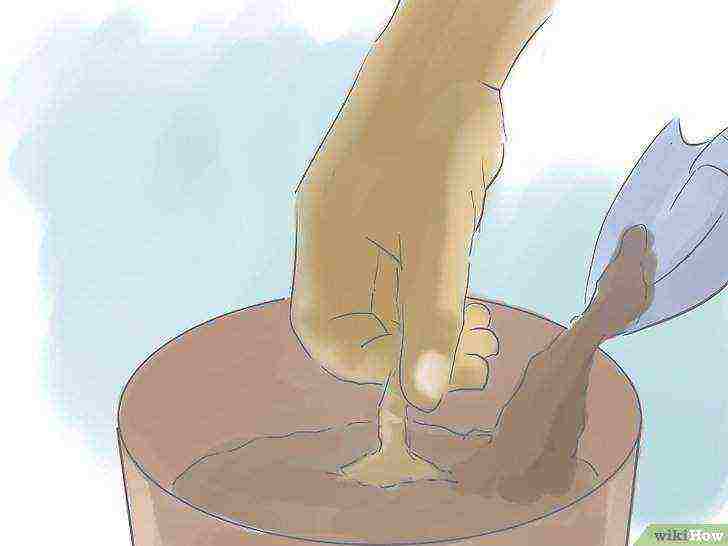 Sprinkle the tuber with a layer of moistened soil about 2–3 centimeters thick.
Sprinkle the tuber with a layer of moistened soil about 2–3 centimeters thick.
Do not overfill the tuber. Cover it with a layer of moist soil 2–3 centimeters thick so that the shoot can easily break through to the surface.
-
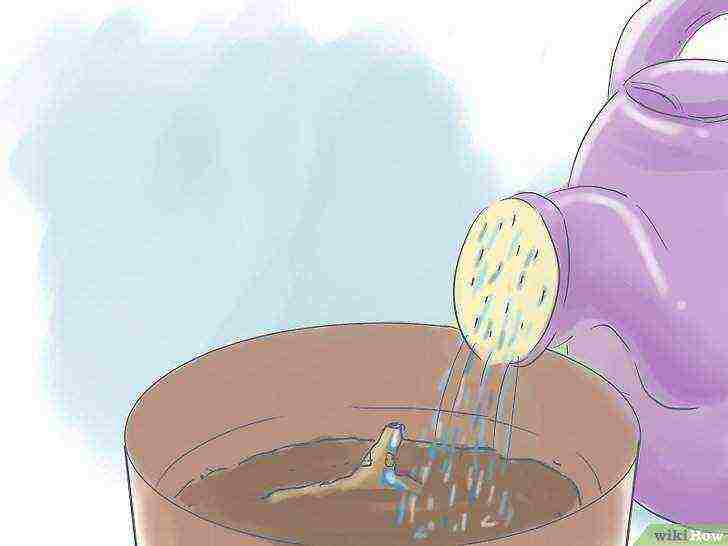 Water the shoots lightly so that the soil is not too wet.
Water the shoots lightly so that the soil is not too wet.
To check if the soil is dry, stick your finger in it. If the soil is dry, spray it with water to moisten the surface.
- Don't wait until the soil is completely dry, but don't water the plant too much, or the tuber will start to rot.
- If you do not live in a hot climate, it is possible that you can do without watering at all until the first shoots with leaves break through.
-
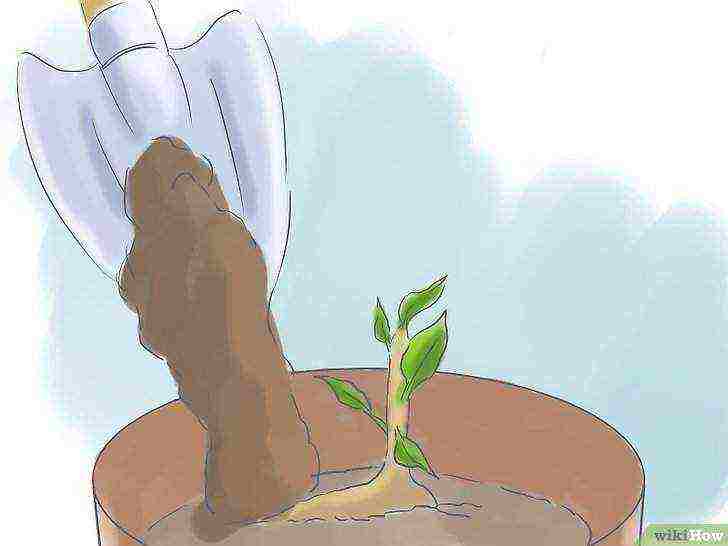 When the stalk is older, add some earth.
When the stalk is older, add some earth.
Do this carefully so as not to damage the young, fragile stem. Cover the sprouted stem with a little soil down to the base of the leaves so that the leaves themselves remain above the ground.
- As the stem grows, continue adding soil a little, so that the distance from the ground level to the edge of the pot is 2–3 centimeters.
- Dahlias grow quite quickly and foliage develops on them within two weeks. Flowers usually appear about 8 weeks after planting.
Part 3 Plant care
-
 Keep the pot in the sun.
Keep the pot in the sun.
For normal growth, dahlias should be in direct sunlight for 6-8 hours a day. It is best to find a place that is illuminated by the sun from morning to noon. Also try to keep the area in the shade during the afternoon, especially if you live in hot climates.
- If you grow dahlias indoors, they will need artificial light from a fluorescent plant light.
- Additional lighting will also be needed if you planted dahlias in early spring and keep them indoors until the last frost. Immediately after planting the tuber, place a lamp about 15 centimeters above the top of the pot and gradually raise it as the plant grows.
-
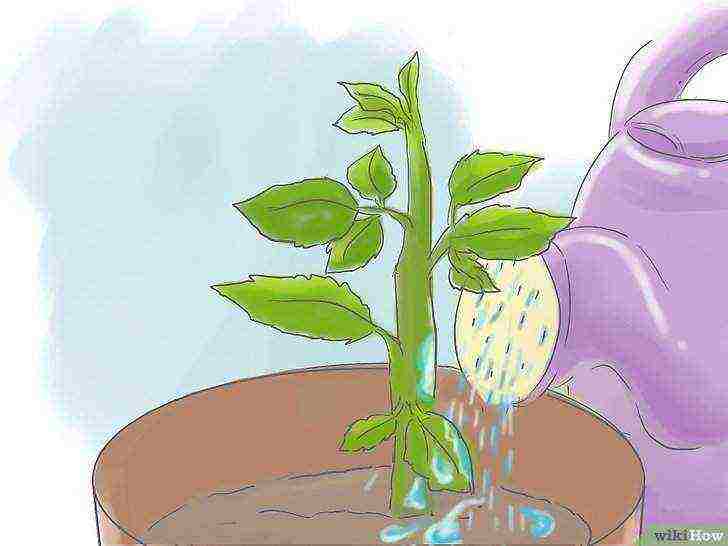 Water the plants well after the sprout has risen above the edge of the pot.
Water the plants well after the sprout has risen above the edge of the pot.
Water the plants well 2 or 3 times a week. If you live in dry, hot climates, water the dahlias daily. Although plants need abundant watering, the soil should not become waterlogged and saturated with water.
-
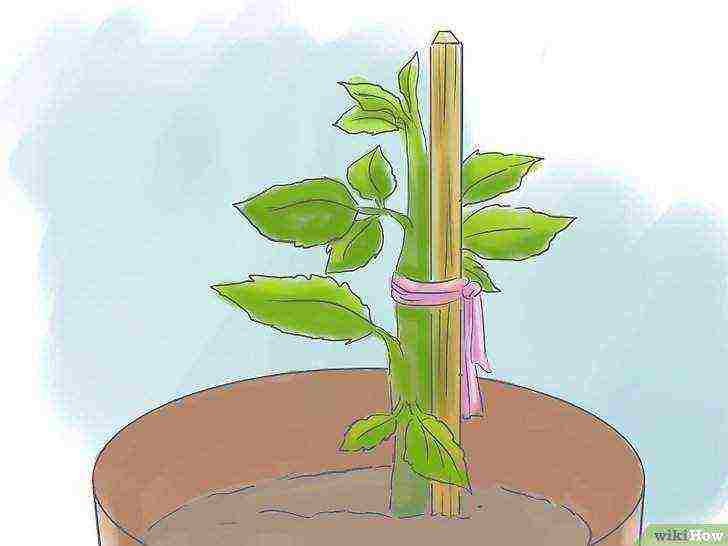 When the stem is 30 centimeters tall, tie it to a post.
When the stem is 30 centimeters tall, tie it to a post.
Use twine or nylon cord for this. As the stem grows, tie it to a support every 30 centimeters.
-
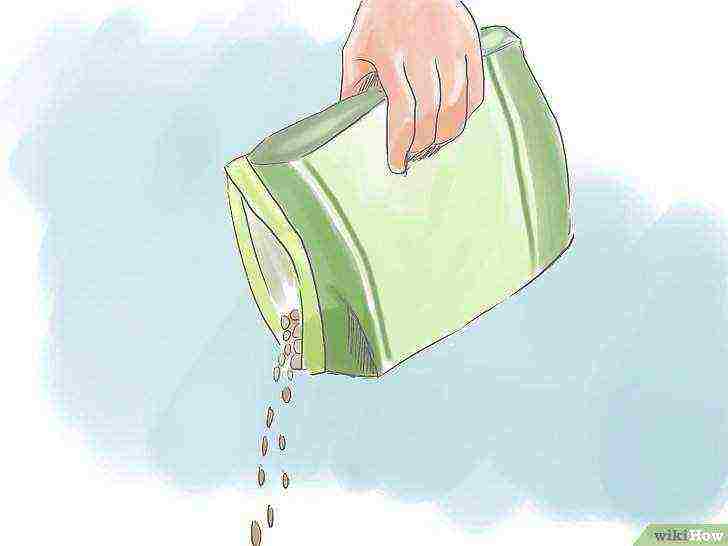 Fertilize dahlias every 2 weeks during flowering season.
Fertilize dahlias every 2 weeks during flowering season.
Use a liquid fertilizer that is high in phosphorus and potassium. Fertilizers work at 8:24:16 or 0:20:20.
- The high phosphorus content promotes the formation of flowers and the potassium aids in root development.
- Use fertilizers according to the directions for use.
-
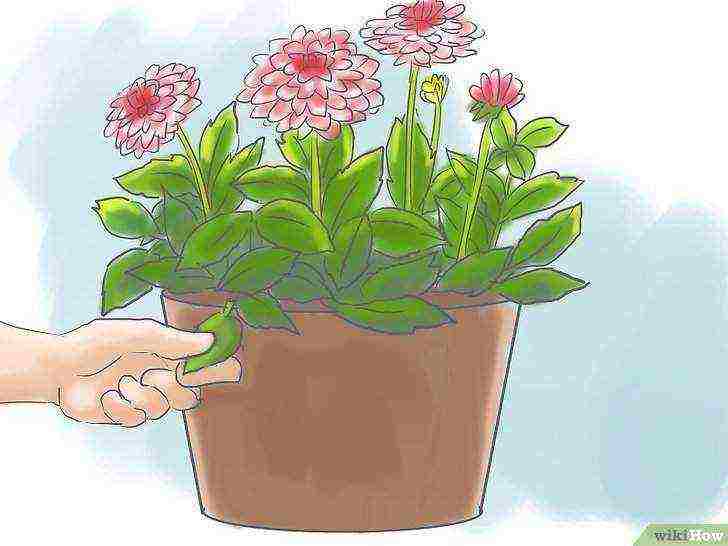 Prune and prune dahlias regularly to ensure healthy growth.
Prune and prune dahlias regularly to ensure healthy growth.
After 4–6 days, the flowers wither and die off. Prune flowers to ensure continued flowering. If you live in the Northern Hemisphere, remove the bottom leaves by mid-summer or around mid-July.
- When the dahlias have reached a height of about 40 centimeters, start pinching off the tops before the buds are tied on them to make the bushes thicker.
- Removing the lower leaves improves air circulation and thus reduces the risk of mold growth.
-
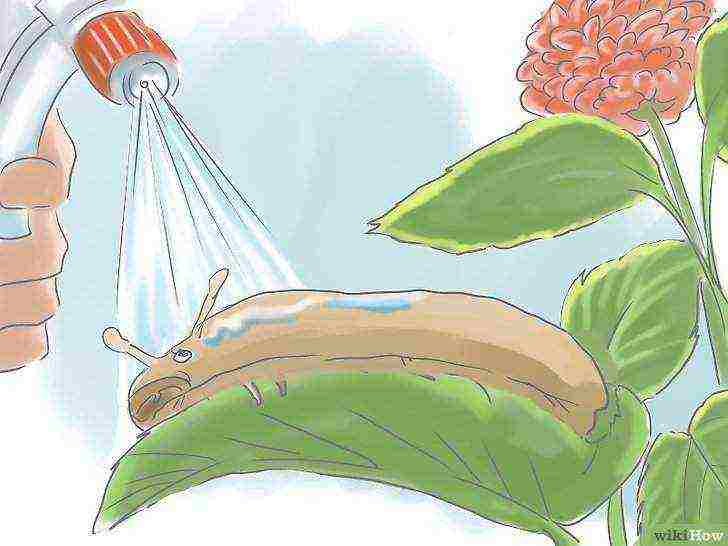 Spray the dahlias with a fungicide or pesticide as needed.
Spray the dahlias with a fungicide or pesticide as needed.
Dahlias are susceptible to many pests, including mold, earwigs, slugs, red mites, aphids, and potato fleas. To prevent infection and disease, spray the plants with a mixture of pesticide and tick repellent every 7-10 days after the plant has reached a height of 15 centimeters.
- You can buy a flower-friendly pesticide and mite repellent at your garden supply store. Observe the directions for use.
- For a more natural remedy, use organic pesticides such as garden soap and neem oil.
-
 Store tubers in a cool, dry place during winter.
Store tubers in a cool, dry place during winter.
The first frosts will destroy the leaves and stem of the plant. When this happens, trim the stem back to a height of 15 centimeters. Wait 2 weeks for the tuber to harden in the pot, then carefully dig it out of the ground. Rinse the tuber with water, let it air dry for one day, then place it in paper, sawdust, or perlite.
- In winter, store the tubers in a dry, dark place at 4–10 ° C, and plant them again in spring.
Advice
- After you cut the flowers, pour hot water over the ends of the cut stems. As a result, the slices will close, moisture will remain inside the stems, and the flowers will be stored longer.
What do you need
- Dahlia tubers
- Large heavy pot
- Trowel
- Potting soil mix for indoor plants
- Fertilizer
- Metal or wooden pole
- Twine
- Gardening scissors
Article Information
This page has been viewed 24,056 times.
Was this helpful?
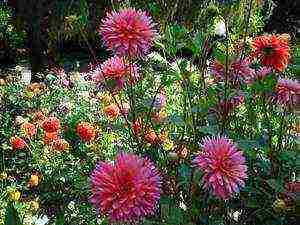 The garden in which dahlias bloom always looks beautiful and attractive. Beautiful flowers do not lose their attractiveness until the very end of autumn. However, not a very large number of gardeners plant dahlias, as they are unfamiliar with the technology of growing dahlias from tubers and storing them.
The garden in which dahlias bloom always looks beautiful and attractive. Beautiful flowers do not lose their attractiveness until the very end of autumn. However, not a very large number of gardeners plant dahlias, as they are unfamiliar with the technology of growing dahlias from tubers and storing them.
Features of growing dahlias from tubers
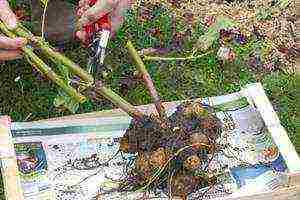 The first reason for not wanting to grow dahlias is the storage of tubers. Gardeners always doubt that they can create all the necessary conditions for storing tubers until next spring. They believe that they can easily purchase tubers in stores, the cost of which is low.
The first reason for not wanting to grow dahlias is the storage of tubers. Gardeners always doubt that they can create all the necessary conditions for storing tubers until next spring. They believe that they can easily purchase tubers in stores, the cost of which is low.
In principle, this is exactly what they do in all European countries. Foreign gardeners do not store roots in the winter. With the onset of autumn, they dig up the tubers and throw them away. With the onset of spring, they acquire new dahlias, cultivation and care, which are carried out constantly.
They don't do that in our country. In late autumn, dahlias are carefully dug up, placed in a well-closing box, then the tubers are sprinkled with sawdust. The tubers of flowers are stored in a deep cellar.
With the onset of spring, the tubers of these flowers are taken out of the cellar and carefully examined. Rotten parts can be removed by cutting with a sharp knife. Small wounds can be sprinkle with wood ash.
The first question that always worries gardeners is how to grow dahlias from tubers, when do you need to start sprouting flowers? Early cultivars can begin to wake up at the end of March. Late varieties are planted directly in open ground.
The earth must be well warmed upwhen no more frost is expected. This usually happens in the last days of May.
When buying dahlia tubers in the store, you must make sure that each of them has live "eyes" that sprout. Dahlia roots are sold by weight, regardless of the number of sprouts. Very often, in colorful bags, you can find dead tubers, all kinds of debris and dry stems.
In this regard, it is necessary see the root well... It is very important that the neck has green buds that will soon begin to grow.
How to grow dahlias correctly
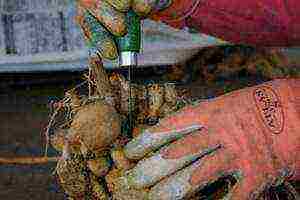 Large tubers must be divided into several parts. If this is not done, the growing stems will begin to interfere with each other.
Large tubers must be divided into several parts. If this is not done, the growing stems will begin to interfere with each other.
Undoubtedly, the bush will grow large, but the flowers will be small and inconspicuous.
Prepared tubers planted in pots... Soil for dahlias can be:
- Sand mixed with sawdust.
- Coconut substrate.
- A mixture of peat and sand.
For good growth, it is necessary to moisten the soil well with water. The tubers are planted so that the neck with the bud is not too deep.
The tubers germinate within a few weeks. The buds finally wake up, green shoots appear. After the sprouts reach 15 cm in length, allowed to start grafting.
The shoot, which has several internodes, is cut off and immersed in water. Usually a couple of drops of a growth activator are added to it. Gardeners often use epin for this.
A tuber with a cut cut will wake up another "eye", a new shoot will appear. By constantly cutting off cuttings, you can get more than 30 new dahlias from one tuber.
If a tuber with a cut cut has two eyes, it also can be divided into parts... Each must have one peephole.
After all operations, sprouted roots, well-rooted cuttings are planted in the ground. When planting, the neck of the dahlia should have a slight deepening so that it can breathe easily.
For convenience, each hole should have small pole, to which it will subsequently be possible to tie a bush.Of course, the pole can be installed in the summer, but there is a danger of injury to the dahlia rhizome. In winter, it will simply rot.
Soil preparation
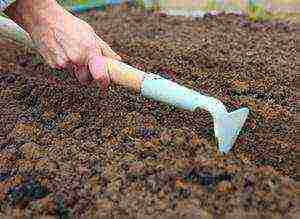 If you are thinking of starting to grow dahlias, then you need to start thinking about planting them with the onset of autumn. The soil must be dug well in advance. It needs to be fertilized with garden compost or manure.
If you are thinking of starting to grow dahlias, then you need to start thinking about planting them with the onset of autumn. The soil must be dug well in advance. It needs to be fertilized with garden compost or manure.
With the onset of spring, the soil must be loosened with a pitchfork and add bone meal... It is forbidden to plant dahlias if plants that have been infected with fungal diseases grew in this soil. To protect the dahlia tubers, the soil needs to be fertilized with granular insecticides.
Landing pit... The size of the depression depends on the size of the tuber. In addition, the fertilizer space is also taken into account. The well should be approximately the following dimensions:
- depth - 25-30 cm;
- diameter - 30–35 cm.
The planting hole is watered with water and fertilizers are added. There must be a distance of at least 50 cm between the pits.
When to start planting dahlias
Dahlia tubers are afraid of even small frosts. Usually, frosts completely disappear with the onset of May. Therefore, dahlias are best planted at the end of the month. Of course, these terms are highly dependent on the climate of a particular area.
Of course, you can plant dahlias earlier, but for any, even the smallest cold snap, they need to be covered with some kind of material.
What care for dahlias is needed
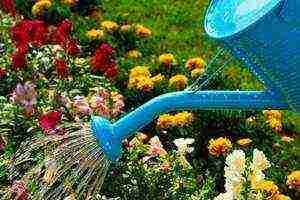 In order for the flowers to be stable in strong winds, it is necessary to carry out the formation of bushes. When the flower begins to grow, to obtain a bright and large inflorescence, you need cut off growing shoots.
In order for the flowers to be stable in strong winds, it is necessary to carry out the formation of bushes. When the flower begins to grow, to obtain a bright and large inflorescence, you need cut off growing shoots.
Bushes that have reached a great height are required tied to a poleso that the strong wind does not break the stem. Proper flower care consists of several steps.
For good growth and rich flowering, flowers must have:
- Fertile soil.
- Sunlight.
- Plenty of water.
Dahlia growing requires constant watering... Water should moisten the soil to a depth of more than 25 cm. If you pour water, the flower can get sick and die. The reason is very simple, high humidity, the enemy of dahlia roots.
Fertilization and feeding
When the plant begins to grow, you need to feed it once every two weeks. Dahlias are watered with slurry water.
When buds appear, the soil is fed using fertilizers that include superphosphate and potassium... For ten liters of water, 30 grams of fertilizer is enough.
If fertilizers have already been added to the soil before planting dahlias, you can skip top dressing. The development of the plant will tell you whether you need to do additional feeding.
Garter and flower support
Dahlias have a hollow and very fragile stem. It breaks easily in strong gusts of wind, even jets of rain can break it. Because of this, the flower be sure to tie up... Any material can become a support:
- Wooden pegs.
- Metal pipe.
- Arches.
- The walls of the veranda.
- Wooden fences.
The garter must be done before the flower stem begins to grow.
Pruning and shaping the bush... For the buds to be large and beautiful, only three shoots are enough. Each peduncle should consist of 2 buds. All blooming buds must be cut off with garden shears, otherwise the growth of new inflorescences will be delayed.
Growing high varieties of dahlias, require during the flowering period, the removal of lateral and lower shoots. If the plant is undersized, to create splendor, the shoots can not be cut off.
How to store dahlias in winter
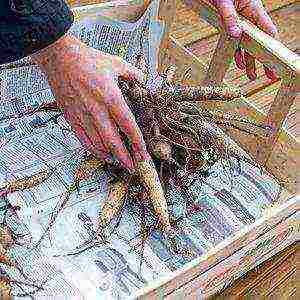 Usually tubers stored in a box, where they are sprinkled with sawdust or sand substrate. It is best to store dahlias by sprinkling them with ash. It will protect the tubers from all kinds of diseases. The tubers should fit snugly against the sand. There should be no empty space in the box.
Usually tubers stored in a box, where they are sprinkled with sawdust or sand substrate. It is best to store dahlias by sprinkling them with ash. It will protect the tubers from all kinds of diseases. The tubers should fit snugly against the sand. There should be no empty space in the box.
To prevent tubers from drying out in winter, they can be stored in plastic bags... In this case, the tuber and the film should be separated by a layer of sawdust or sand. This is necessary, since during storage, the tubers release a small amount of moisture. It settles on the film, the tubers begin to rot.
Storing tubers in a plastic bag requires constant monitoring of the state of the substrate. With its high humidity, the bags must be opened and ventilate the contents well... If the substrate is very dry, it needs to be slightly moistened.
If a rotting area is found on the tuber, it must be cut off. Sprinkle the cut area with powdered charcoal. This tuber is left to air dry for 24 hours. Then it is put back in the plastic bag.
If you follow all the rules described above and adhere to the technology, then growing dahlias will be a common thing, and good flower care will allow you to decorate your garden with beautiful flowers that will delight the eye before the frost begins.
Rate the article:
(3 votes, average: 3.7 out of 5)
Dahlias popular among gardeners, despite their height, can be grown at home in pots. But at the same time, you need to take into account the specifics of growing and select the appropriate varieties.
Choosing a dahlia variety that is suitable for growing in pots
For planting dahlias at home or on the balcony, varieties with a small root system are selected. Special varieties of indoor low-growing dahlias have been developed - for growing in pots at home. These are pot-dahlias, miniature dahlias, etc. But you can also grow high varieties. It is important to choose the right container for planting and take care of the support if the flower has grown to 85-90 cm.
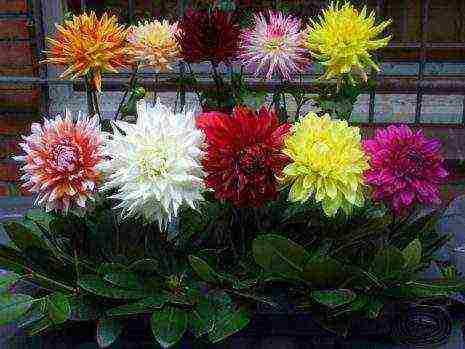
Pot selection
Indoor dahlias can be planted in plastic containers, wooden, wicker, clay, different sizes. What's better?
What container to use
In plastic containers, overheating of the soil is possible, the access of oxygen to the roots is reduced. Wicker baskets do not have these drawbacks, but they are usually short-lived. Wooden boxes are comfortable for flowers, but not decorative enough for a room or balcony. For attractiveness, they can be painted, but then air permeability is impaired. In a clay or ceramic pot, the roots of dahlias do not lack oxygen. These pots are attractive and durable.
I need to find a big pot
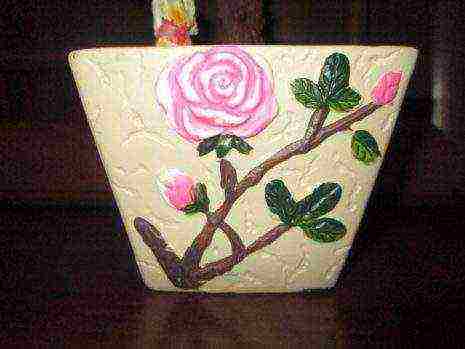
To plant a dahlia, you need a large pot. When choosing a volume, you should take into account the dimensions of the flowers. The size of the root system for low varieties requires a capacity of 4-5 liters. Medium-sized dahlias will feel comfortable in pots of 7-8 liters. For flowers with a height of more than 90 cm, 10 liters or more will be required.
Better to choose a heavy pot
The pot must be heavy. An adult dahlia requires a stable support, so plastic or wicker containers are not suitable. A thick-walled clay pot is able to provide the stability of the flower.
Drilling holes
Dahlias do not tolerate excess moisture. If the water stagnates in the pot after watering, the roots will die due to the lack of oxygen. It is necessary to ensure the outflow of water through the drainage holes. If there is only one drain hole, several more need to be drilled to improve drainage.
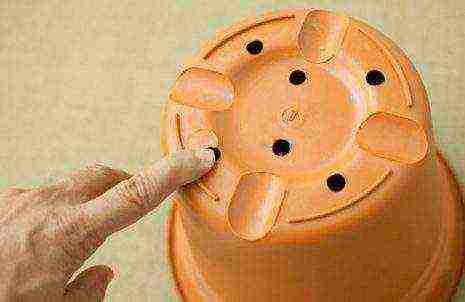
Why is it necessary to rinse the pot thoroughly?
When using used pots, they must be pre-treated. Clay can contain microorganisms, insect eggs, fungi, accumulate salts, etc. Therefore, before use, the pot should be thoroughly washed with soap and water and disinfected with a chlorine-free product.
Coarse soil mix
Dahlias are demanding on the quality of the soil. You can buy ready-made soil mix or mix it yourself.The soil should be coarse, loosened to provide air access to the roots. Peat, humus, sand are added to it. Experienced growers advise mixing perlite, hygroscopic granules of which remove excess moisture from the soil.
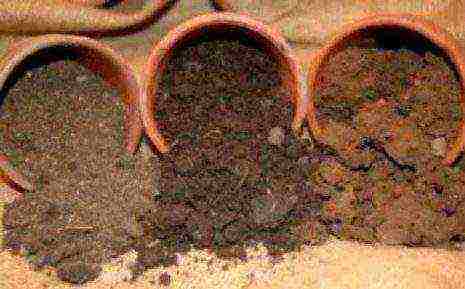
Landing
It is important to correctly determine the timing of planting so as not to spoil the planting material.
Landing dates
If the pots are in an apartment or on a heated balcony, then tubers can be planted as early as late March - early April. If the pots are planned to be exposed to the open air (on the porch, in the garden or on the open balcony), then it is better to wait until May, when even at night it will be at least 120C.
Potted dahlias begin to bloom about 45-50 days after planting. This period can be reduced by providing the plants with warmth and sunlight.
Filling the pot
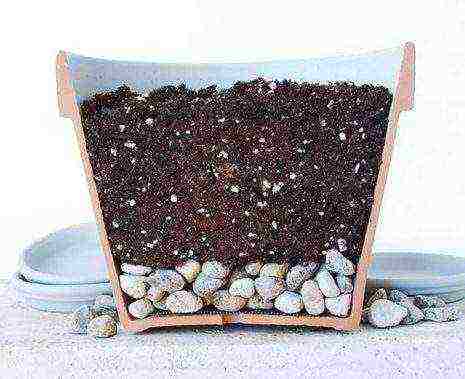
When filling the pot, pay special attention to the drainage layer.
ADVICE!
Experienced growers advise placing one or two coffee filters on the bottom of the pot. They absorb moisture well and block the drainage holes, blocking them from pests.
You can add gravel to the bottom of the pot. The height of the drainage layer is about 15 cm. The drainage holes must remain free to allow water to drain out. Soil is poured onto the drainage. The height of the soil depends on the pot - about 20 cm should be left to the top edge.
The tubers are planted to a depth of about 15 cm. After planting, germination and backfilling of the tubers, the distance from the ground to the edge of the pot should be at least 2 cm. The backfilled soil is moistened and slightly crushed - the ground should be loose.
Planting tubers
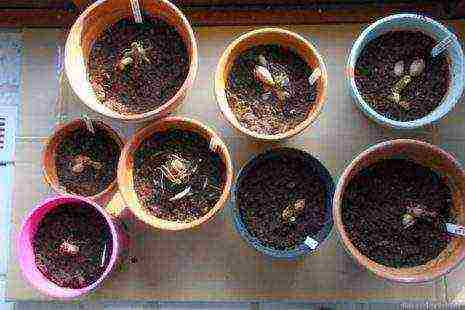
Tubers with short roots should be planted. If the roots are allowed to elongate, they will intertwine and be damaged when untangled. Root restoration will delay the growth and flowering of the dahlia.
The tuber is laid on the ground with the eye upwards so that the stem can grow unhindered. It is desirable that the sprout is located approximately in the center of the pot, and the distance from the ends of the roots to the wall of the pot is at least 5-6 mm.
The tuber is sprinkled with moistened soil, you do not need to fill up the peephole. As the stem emerges and grows, the soil is added, but very carefully so as not to damage the delicate sprout. The addition of soil continues until the distance to the edge of the pot decreases to 2-3 cm.
The pot with the planted dahlia is placed in a warm, bright place protected from the wind. Slight shading is possible in the evening.
Watering the soil
 You may be interested in:
You may be interested in:
For planting, the soil is moistened. After planting, the dahlia does not require watering, the soil is only lightly sprinkled with warm water. Watering begins a few days later, after the formation of absorbent roots.
Fertilizers
For rapid growth and lush flowering, flowers require feeding. Dahlias respond well to fertilizers based on algae and fish, bone meal. You can buy a ready-to-use plant feed mixture at a specialty store.
Apply fertilizers with high nitrogen levels carefully. An excess of nitrogen leads to diseases of dahlias, they bloom poorly, the tubers do not tolerate wintering well.

Inserting a stanchion and anchoring the stem
For flowers of medium to tall growth, additional support will be required so that the stem can support the weight of the flower. As a rule, the height of the support does not exceed 120 cm. The support must be stable - it is inserted into the ground to the very bottom and, if necessary, is additionally attached to the pot (for example, using a wire).
The stem is carefully tied to the support.
ADVICE!
Dahlias do not tolerate transplanting well, so experienced flower growers advise to immediately plant the tuber in a pot in which the flower will grow.
Care
Caring for potted dahlias is simple and includes:
- watering,
- loosening of the soil,
- top dressing,
- protection from diseases and pests.
If potted dahlias grow in the open air (on an open balcony, veranda, porch), then in adverse weather conditions they are simply temporarily brought into the room.
Watering the stem and soil
Dahlias do not tolerate excess moisture. Watering frequency depends on the weather. This is usually two to three times a week. If it's cool, just once is enough, depending on the condition of the soil. In dry and hot weather, you can water daily without allowing moisture to stagnate.
ADVICE!
After watering, it is necessary to loosen the soil. Otherwise, a dried earth crust is formed, which does not allow oxygen to pass to the roots.
Lighting
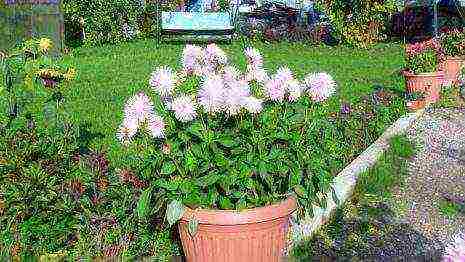
Dahlias love sunlight. For high-quality growth and flowering, they need about 6-8 hours to be in direct sunlight. If the pots are on the balcony, choose the sunniest place for them. If dahlias are growing in a room, then it is useful to make up for the lack of sunlight with fluorescent lamps. The lamp can be installed immediately after planting at a level of 15 cm above the ground. As the dahlia grows, the lamp rises.
Fertilizer timing
Dahlias need a lot of potassium and phosphorus, to a lesser extent - nitrogen. Top dressing begins in June. Fertilizers are applied every two weeks when watering. Overfeeding with fertilizers should be avoided. Top dressing continues until September.
Removing the lower leaves
Around mid-July, the lower leaves are removed from the stem to improve air circulation. It also protects plants from powdery mildew disease.
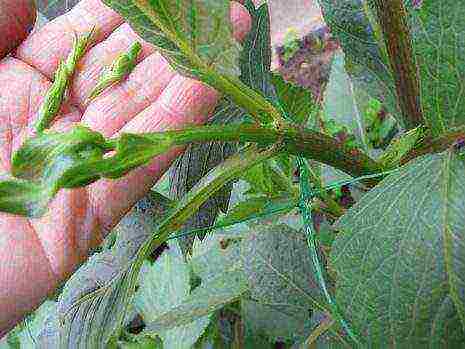
Spraying with insecticide and fungicide
To protect against pests, potted dahlias are treated with a fungicide or insecticide twice a month.
Pests and methods of dealing with them
Yellowed and curled leaves are a signal of the appearance of aphids. If the colonies are single, then the damaged leaves are simply removed. In case of severe infection, an insecticide treatment is necessary.
Slugs gnaw through or completely destroy the leaves. To combat them, metaldehyde preparations, superphosphate, red pepper are effective - they scatter on the ground.
Plant bugs cause leaf boring. To get rid of them, dahlias are sprayed with insecticide. The treatment is best done in the morning, when the bugs are inactive.
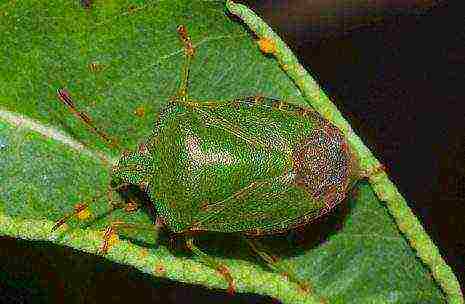
Earwigs spoil the buds, gnawing out their core. Watering once a week with a decoction of wormwood or celandine helps from earwigs.
When mold appears, fungicide treatment helps.
In case of a disease with powdery mildew, treatment with a preparation containing copper is necessary. Sulfur treatment can be applied.
Wintering dahlia
With the first autumn frosts, even if dahlias grow in the house, you need to think about winter rest. Before winter, the dahlia is cut, leaving 4-5 cm of the stem. The tubers can be dug up or left in the same pots in which they grew.
The dug tubers are carefully cleaned from the ground, treated with a solution of potassium permanganate of medium brightness and dried. They are stored in a cool dry place at an air temperature of about 50C. So that they do not dry out during storage, the tubers can be sprinkled with sawdust, sand, peat.
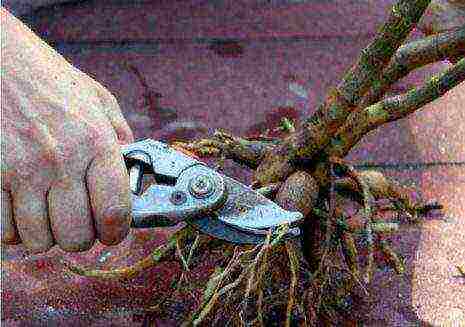
During wintering, protruding roots are cut off in a pot, the pot is wrapped in newspaper in several layers and packed in an opaque bag. Until spring, the pots should be kept in a cool dry place.
3 methods: Preparation Planting Care
Dahlias are beautiful and vibrant flowers in a wide variety of colors. They are quite tall, and therefore many gardeners are skeptical about growing them in pots. In fact, if the pot is large enough, dahlias can thrive in it, but varieties that reach 90 cm or more in height may need additional props.
Method 1 Preparation
-
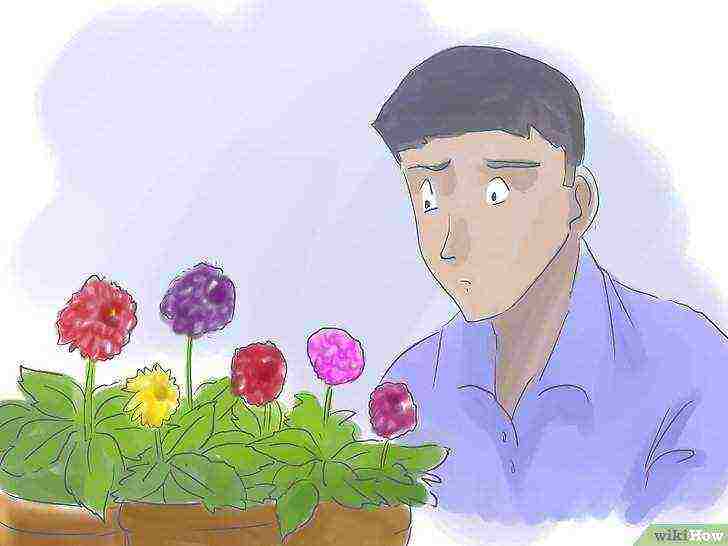
Choose a dahlia variety that is suitable for growing in pots. Dwarf and undersized varieties are preferred, but you can grow almost any dahlias this way, as long as you have a large enough pot.
-
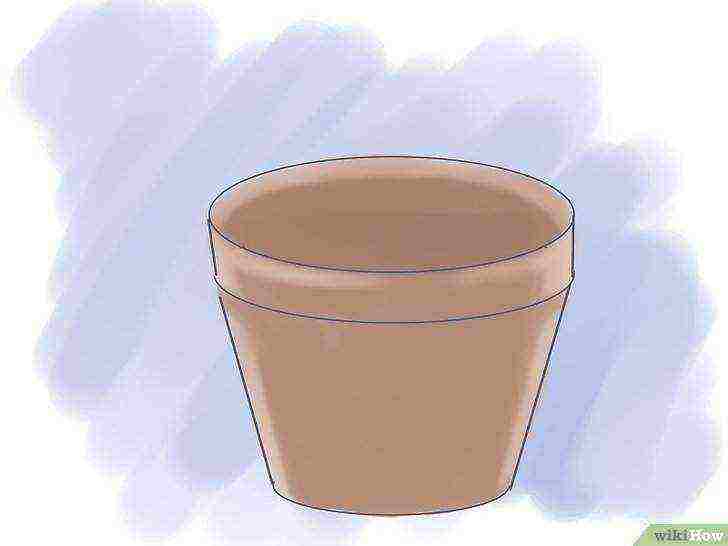
Find a large pot. A pot with a depth of about 30.5 cm and the same diameter is a good place to start. Larger varieties, especially those taller than 90 cm, may require a larger container.
-

Choose a heavy pot. A light pot may not be stable enough, so choose one that won't tip over under the weight of an adult plant.
-
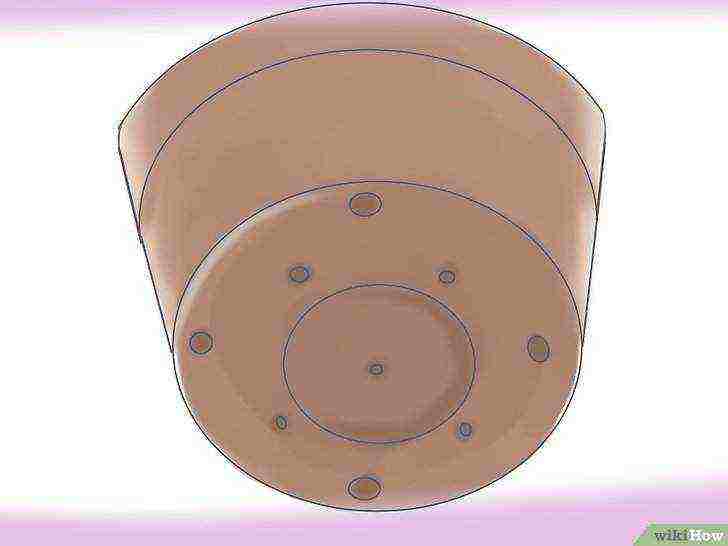
Drill additional drain holes. You can skip this step if your chosen pot already has several holes that allow excess water to drain off quickly. If the holes in the pot are too small, or there is only one hole in the middle, you may need to make a few more holes to improve drainage.
-

Wash the pot. A dirty pot can be a source of disease or insect eggs. Get rid of this threat by washing it out before planting the plant. All you need is soap and water.
-
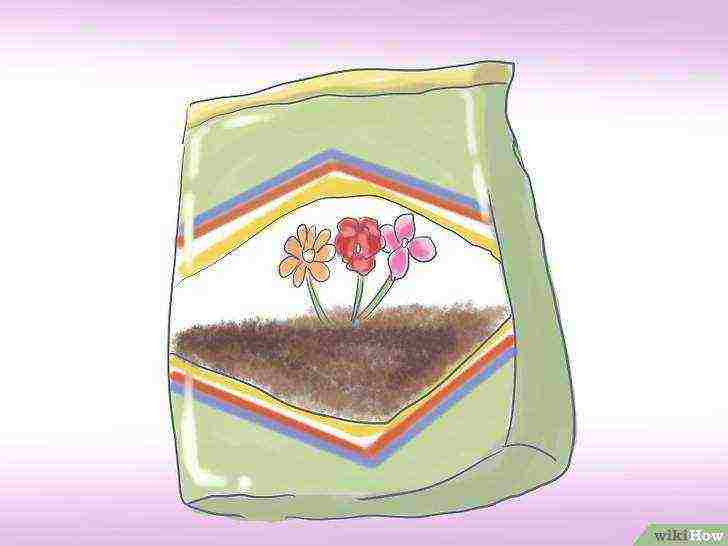
Choose a coarse soil mixture. Standard potted soil is too porous, which can lead to poor bud development. A good mixture will consist of potting soil and garden soil, or potting soil and compost. Alternatively, mixtures of other components - bark, peat and various minerals - may be suitable.
Method 2 Landing
-
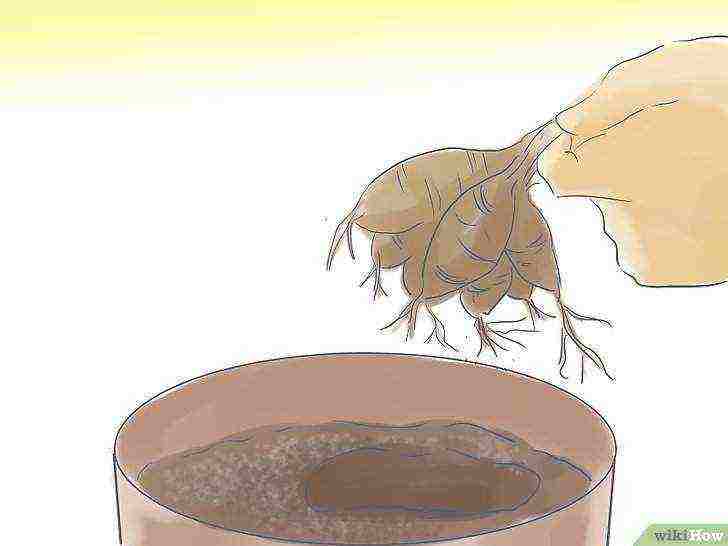
Plant the tubers before the roots grow too long. Long roots become tangled and easily damaged when untangled. It will take time for the tuber to grow new roots, and as a result, the growth and flowering of plants can be delayed and be minimal for the season.
-
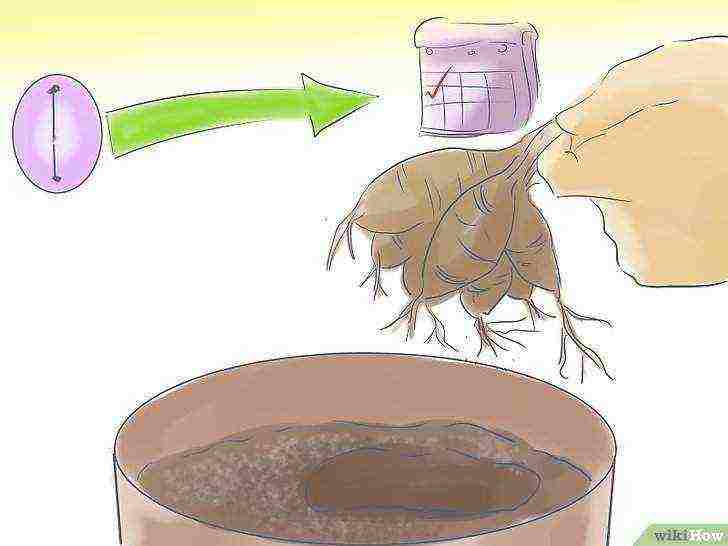 Start in April or May.
Start in April or May.
- If you are planting potted flowers that will stand outside, wait until May (the ground should not freeze through at night).
- If you are growing indoor flowers, you can start planting tubers as early as April.
-
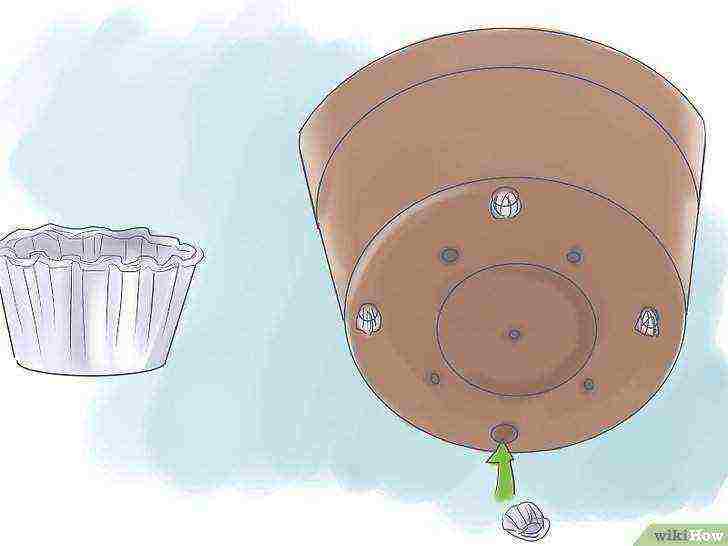
Place one or two biodegradable coffee maker filters in the bottom of the pot, over the holes. The filters will absorb moisture, preventing root flooding. Gravel poured into the bottom of a flowerpot does the same job, but the roots of dahlias need as much space as possible to grow, and filters take up significantly less space than gravel. In addition, the filters will prevent insects from entering the pot through the drainage holes.
-
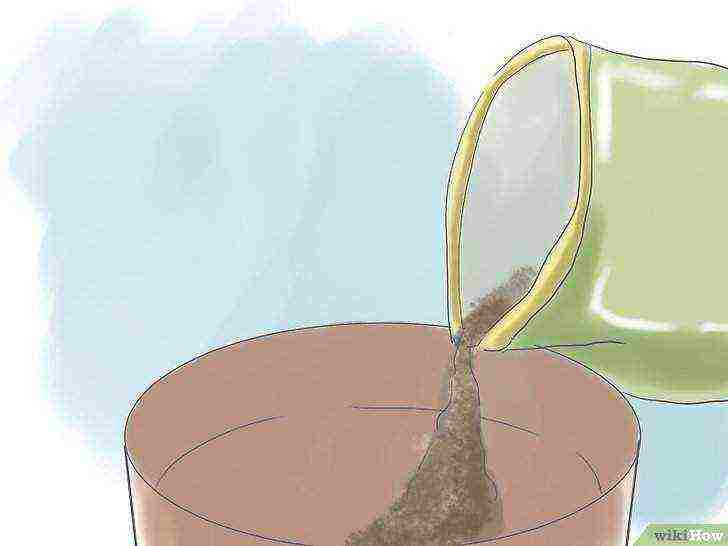 Fill the pot one-third full with the soil mixture.
Fill the pot one-third full with the soil mixture.
Do not tamp it tightly - keep the ground loose.
- If your pot is deeper than 30.5 cm, you may need more soil. Dahlia tubers should be planted to a depth of about 15 cm, and 2.5 cm should remain from the surface of the soil to the top edge of the pot.
-
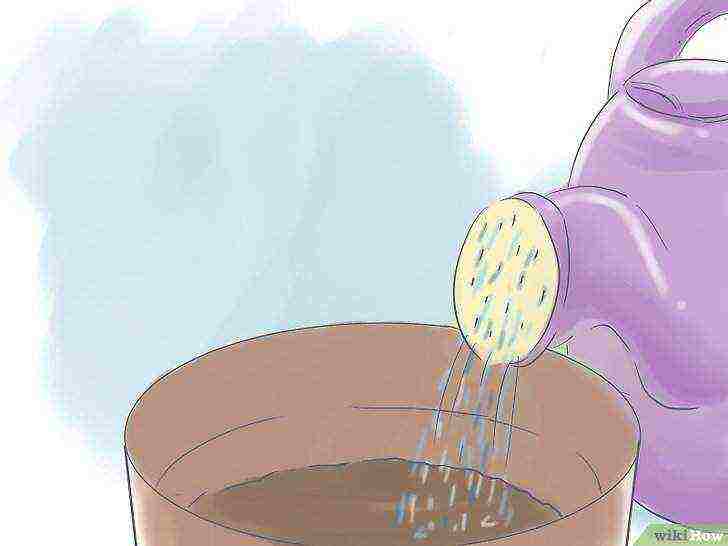
Moisten the soil. It should be exactly wet, not wet.
-
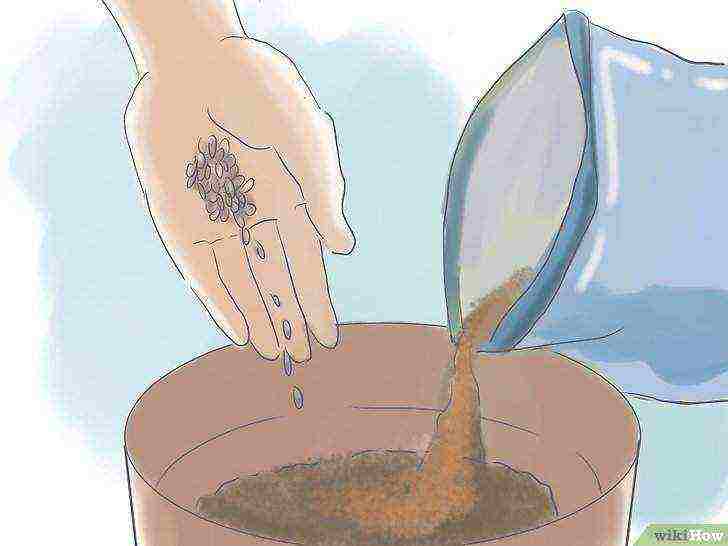 Mix the soil with a handful of bone meal and fertilizer.
Mix the soil with a handful of bone meal and fertilizer.
Dahlias need a lot of nutrients to grow lush. Fertilizers based on fish or algae additionally contain trace elements.
- You can also purchase resin blend from your gardening store and use it in place of bone meal and fertilizer. Follow the directions for use on the packaging.
- If the coffee filters on the bottom of the pot become dislodged when you add a mixture, fertilizer, or bone meal to the soil, shake the soil out of the pot and mix it with the other ingredients. Then put the filters back in place and pour the soil and additives back into the pot.
-
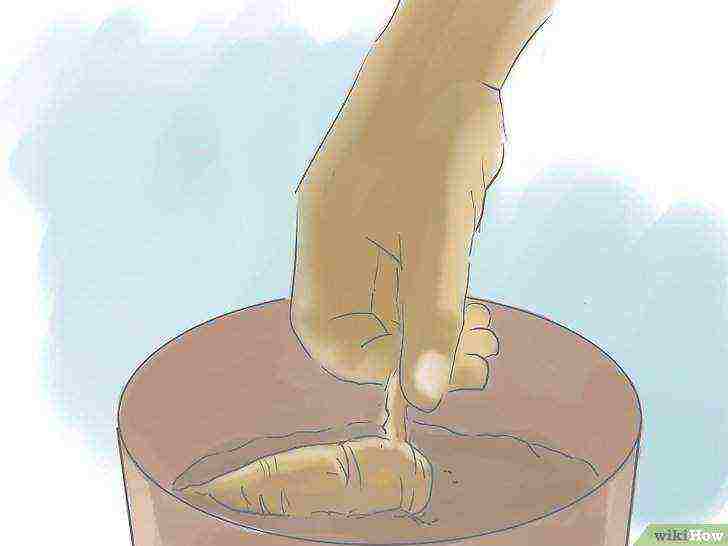
Plant the tuber in the soil. Lay it horizontally and leave at least 6 mm between the tip of the root and the side of the pot. If a peephole has already appeared on the tuber, position it so that the peephole is in the center of the pot and looks up. The stem will grow out of this eye.
-
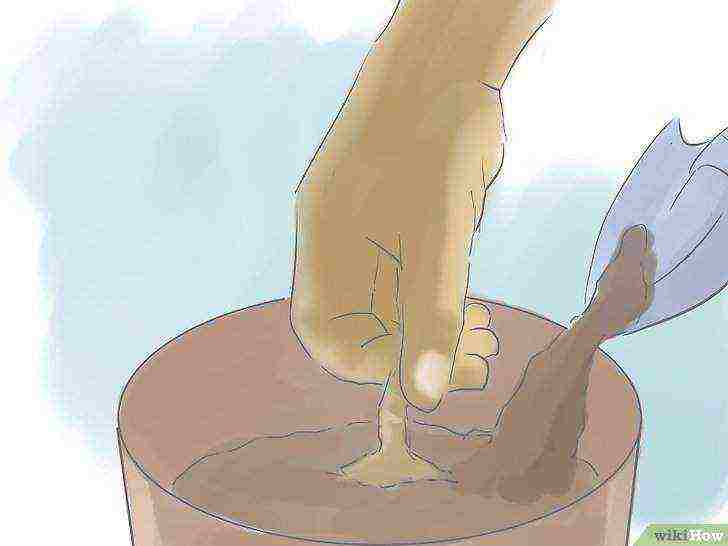
Cover the tuber with pre-moistened soil. Do not bury the tuber deeply yet, just sprinkle it with a minimum amount of soil to watch it grow.
-
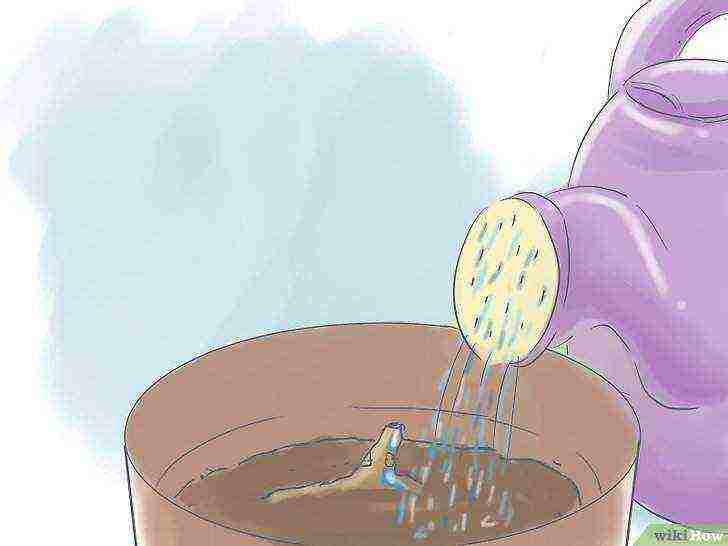
Do not cover the eyes with soil; leave them on the surface. Lightly sprinkle the visible part of the tuber with lukewarm water to moisten it.
-
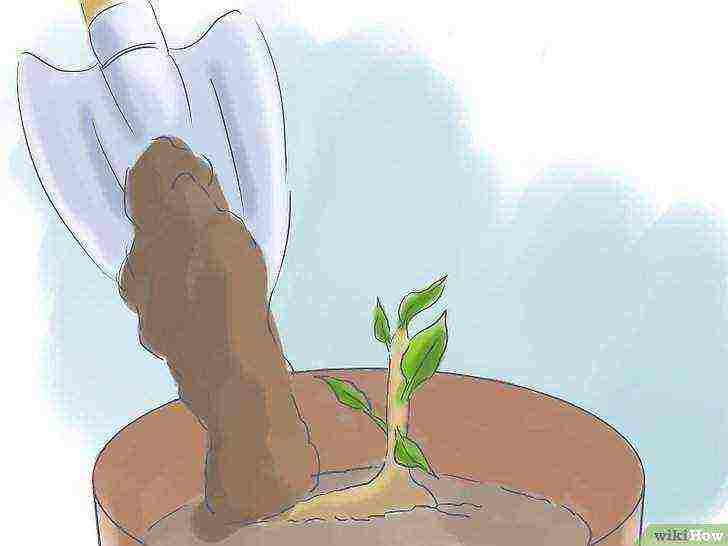
Add soil as the stem grows. Do this carefully so as not to damage the stem, as it is still quite fragile at this stage. Never cover the top leaves. Continue adding soil until only 2.5 cm is left between the surface and the edge of the pot.
-
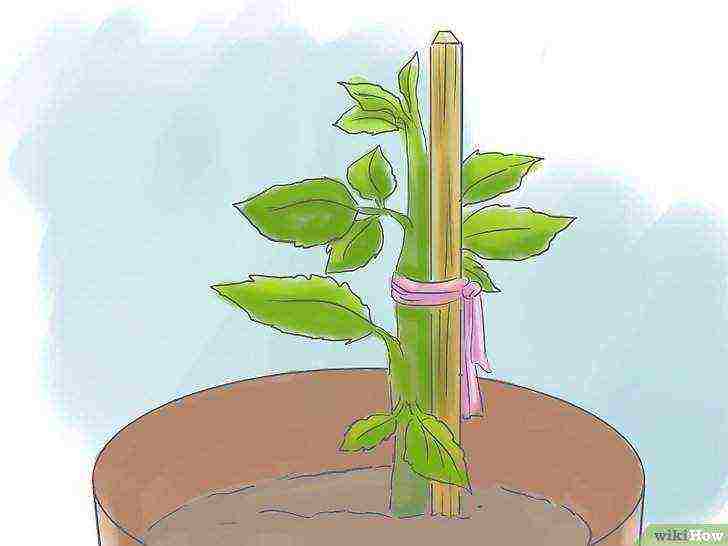
Insert a support into the pot and tie the stem to it. Large varieties of dahlias need extra support to keep the stems from breaking. For most, a 120 cm high support is suitable; the most reliable will be metal. The base must reach the bottom of the pot, and the stand itself must be firmly anchored with soil and / or wire threaded through the holes drilled in the sides of the pot.
Method 3 Care
-
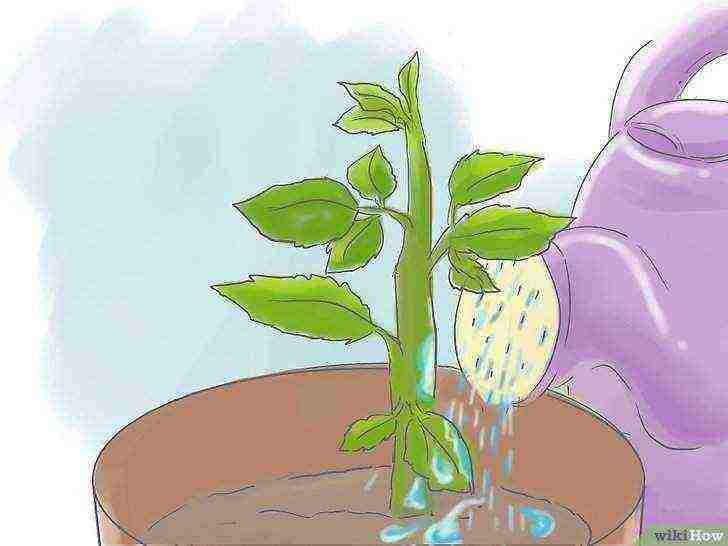
Water the tubers well when the stem rises above the edge of the pot. Provide abundant watering two or three times a week. In dry and hot climates, dahlias require watering every day. However, never overfill them.
-
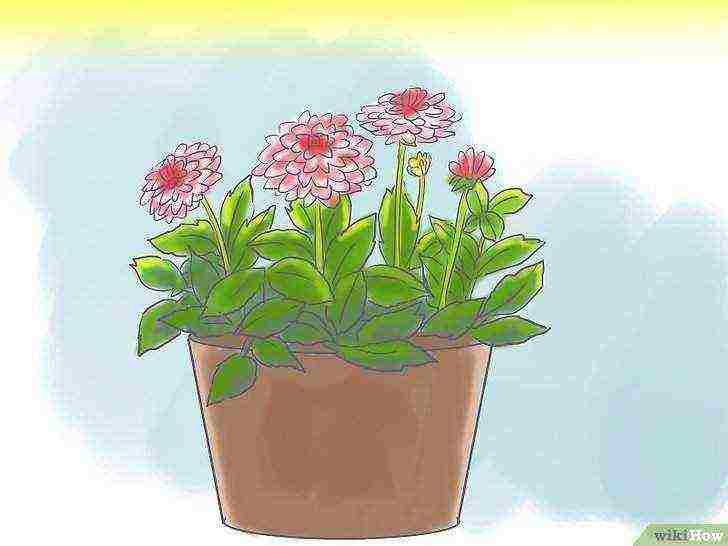
Place the pot in full sun. Dahlias grow best in six to eight hours of direct sunlight.
-
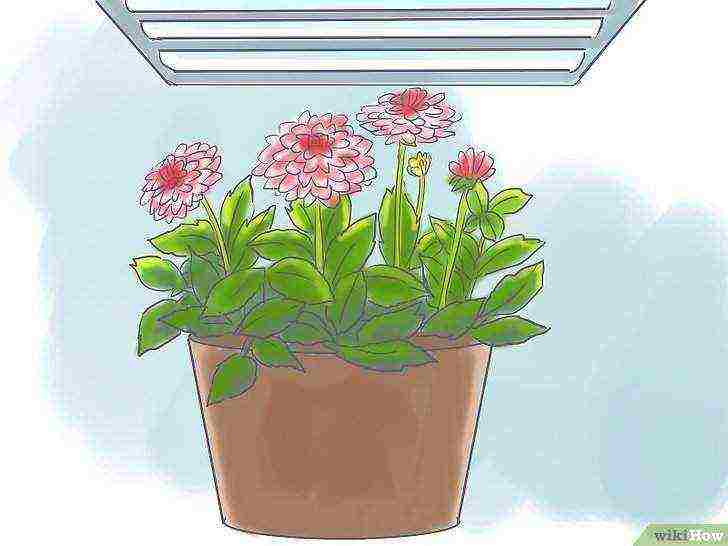
Supplement sunlight with fluorescent lights if you are growing flowers indoors. Indoor dahlias often receive less sunlight, and special lighting may be needed to stimulate growth. For freshly planted tubers, place a lamp about 15 cm above the top of the pot and raise it as the dahlias grow.
-
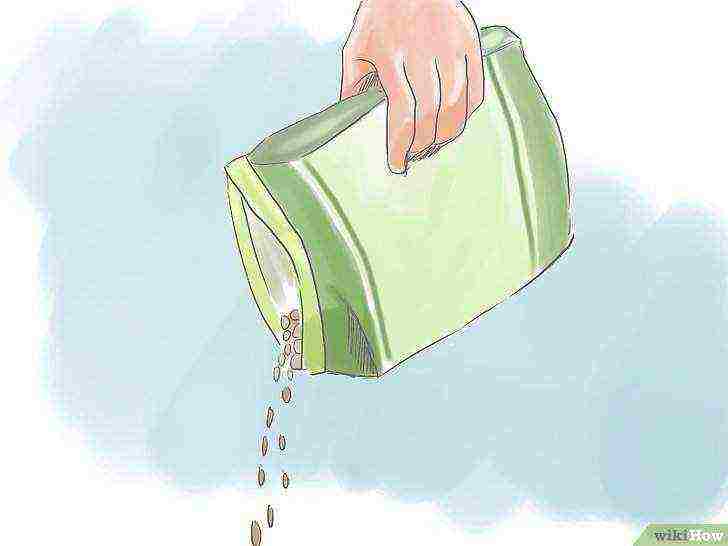
Fertilize biweekly from June to September. Use a fertilizer with low nitrogen levels and avoid overfeeding the flowers.
-
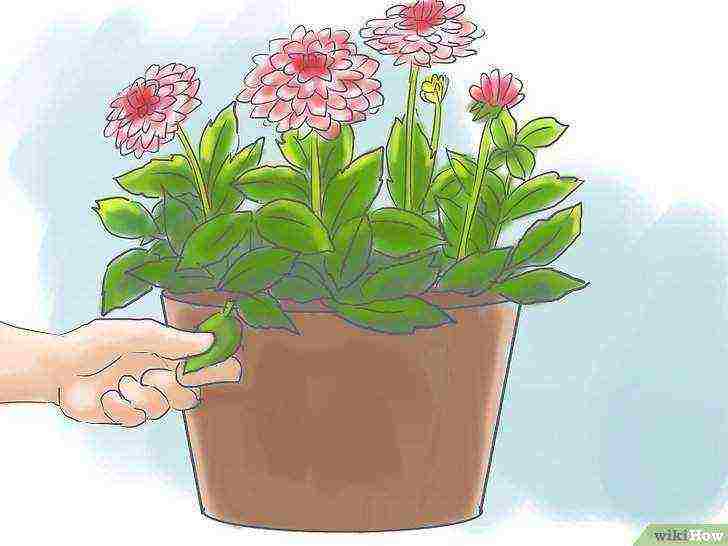
Remove the lower leaves over time (usually mid-July). Removing them will improve air circulation and reduce the risk of powdery mildew.
-
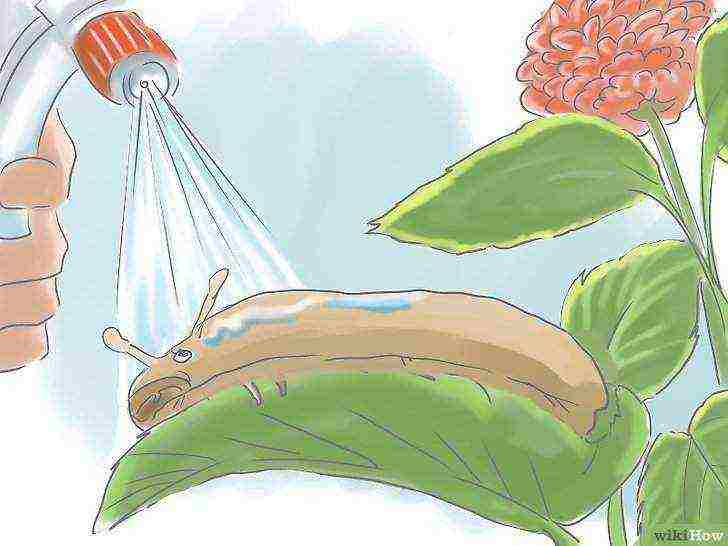
Spray the dahlias with a fungicide or insecticide as needed. Dahlias are harmed by mold, earwigs, slugs, spider mites, aphids and leaf beetles.
Advice
- When cutting dahlias for a bouquet, dip the ends of the stems in hot water. This will help trap moisture inside and extend the life of the flowers.
- If you live in cold climates, let the dahlia tubers winter indoors. Dig up the tubers two weeks after the plants are frozen. Rinse off any dirt and let dry throughout the day. Then wrap in paper and store in a cool, dry place.
What do you need
- Dahlia tubers
- Large heavy pot
- Priming
- Low nitrogen fertilizer
- Fluorescent lamp
- Metal support
Article Information
This page has been viewed 22,844 times.
Was this helpful?
Dahlias are popular flowering garden plants from the Asteraceae family, on rather tall stems, with bright flowers of various colors from pink to bright red.
These flowers are also grown indoors using special potted varieties that reach only 30 cm in height. It is only important to follow the rules of care.
Dahlia growing
Location and lighting
These flowers are light-loving, but in summer, during the hottest hours, they are shaded from the sun. It is best to place the pot on the east or west window.
The room in which the plant is located must be well ventilated; in the summer it can be taken out onto the balcony or into the garden, protecting it from drafts and wind.
Temperature
Dahlia is not very thermophilic. In summer, the temperature should not exceed + 18 ° С, in winter it is lowered to + 12-15 ° С.
Watering and humidity
Throughout the year, abundant watering is required, in winter they slightly reduce the amount of water, but still do not allow the soil to dry out. For irrigation, the water is defended for 1-2 days.
It does not require high humidity; it is enough to periodically spray the leaves with water at room temperature. If the air is too dry, pests can appear on the plant, and the leaves also turn yellow.
Fertilizer
Top dressing is required a few days after transplanting, this is done in late spring and summer with an interval of 10 days.
The best fertilizer is a mixture of mullein infusion (1 part to 10 parts of water) with the addition of superphosphate and nitrogen fertilizers (they are taken for 10 liters of water 20 g).
Periodic feeding with superphosphate mixed with wood ash is also suitable (for 10 liters - 50 g of the product).
The use of fertilizers has a beneficial effect on flowering - large and bright flowers are formed. Since September, feeding is not carried out.
Transplant and reproduction
They practically do not transplant, since at the end of flowering, the ground part of the plant usually dies off.
Dahlia propagates by seeds that form on flowers. They are collected, dried a little and planted in the soil in the spring (a mixture of peat and sand in a ratio of 3: 1), when 2 true leaves grow on the seedlings, they are planted in separate pots.
The second way of reproduction is with cuttings. To do this, cut off the tops of the stems, place them in a container with water or a mixture of peat and sand. For rooting, maintain a temperature of + 20-25 ° C.
Transplanting the plant with tubers, they are cut into several parts so that a piece of the root collar with eyes remains on each. Tubers are planted in the ground in May-June.
Pests and the fight against them
Dahlias are threatened by pests such as aphids and spider mites. To get rid of them, plants are sprayed with infusion of onion peel, garlic, dandelion or tobacco. In case of severe damage, special insecticides are used.
Share with your friends on social networks

